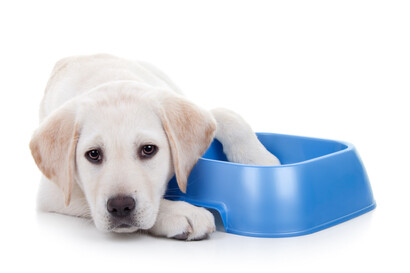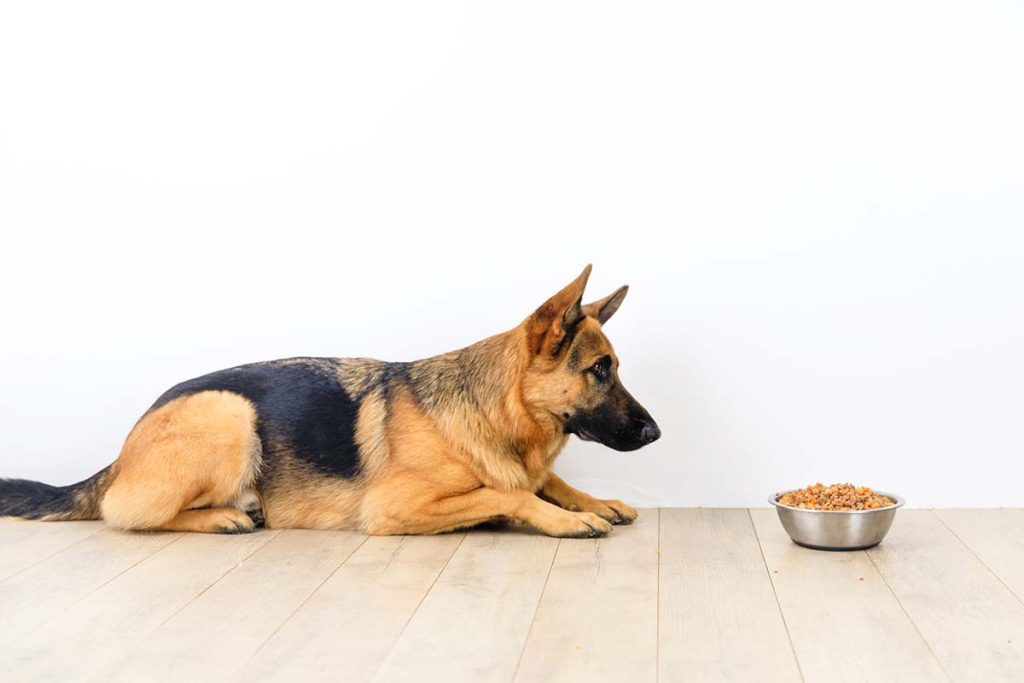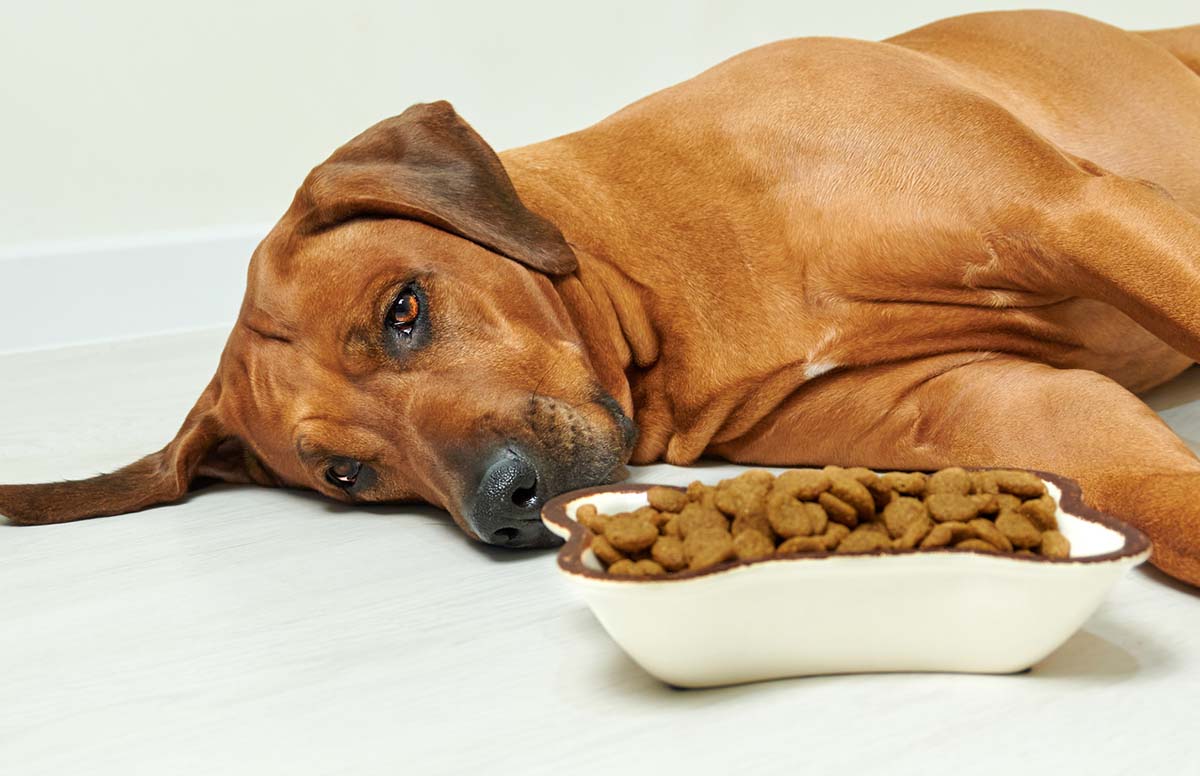Why Is My Dog Not Eating?
Whether not eating comes from a selective palate or an underlying health problem, it’s important to get to the bottom of the issue and address it.
As any pet parent can attest, when your beloved dog stops eating for some unknown reason, it can feel pretty overwhelming. There are countless reasons a dog may stop eating, some more serious than others.
If a dog who usually has a robust appetite suddenly stops eating, it could be the first sign of a health problem. Some dogs are lifelong picky eaters, and others occasionally refuse meals here and there, which makes it hard for dog owners to tell the difference between problematic behavior and a phase that will soon pass.
One thing is certain: Whether not eating comes from a selective palate or an underlying health problem, it’s important for pet parents to get to the bottom of the issue and address it.
All dogs need to eat a balanced, nutritious diet in sufficient quantities for them to thrive. When your dog’s not eating, here’s a helpful guide to help you get him back on the right track again.
Why Is My Dog Not Eating But Drinking Water? 9 Possible Reasons.

Sometimes, a loss of appetite in dogs can be attributed to something as simple as a dog not liking his food. According to Board Certified Veterinary Nutritionist, Dr. Dan Su, MS, DVM, DACVIM-Nutrition, dogs who are used to eating one food stage a hunger strike when they are switched to a new food that isn’t as tasty. This often happens when a dog needs prescription food to manage a health condition since many prescription diets aren’t all that tasty.
Aside from preference, there are many other physical and behavioral reasons that can cause a dog not to eat even when water intake is normal. Here are nine common reasons why dogs may go on a hunger strike.
1. Dental disease
When a dog stops eating, dental problems are a common culprit. Dental conditions like broken teeth, abscesses, severe gingivitis, and oral tumors can be extremely painful. Dogs don’t always let on when they are hurting, but they might stop eating.
2. Medical issues
A lack of appetite is often one of the first signs that a dog is feeling ill or has an upset stomach. Maybe your dog was eating a first but keeps throwing up. Almost any illness or disease can cause a dog to stop eating, including infections, intestinal blockage, heart disease, kidney failure, liver disease, and cancer.
According to Su, dogs who experience recurring gastrointestinal issues or pancreatitis (inflammation of the pancreas) might have an on-and-off appetite when the condition flares up.
If your dog seems to be drinking an excessive amount of water, other conditions like Cushing’s or Addison’s disease could be the culprit. Drinking a lot of water is one thing, but inhaling it all at once several times a day could be something more serious. If emptying the water bowl is accompanied by an abnormal amount of peeing, take your dog to the veterinarian for testing.
“Any disease in the early stage that isn’t presenting with very obvious clinical signs can cause a decrease in appetite,” says Su. That’s why it’s so important to take your dog’s loss of appetite seriously. It could be the key to diagnosing an underlying cause early, which could lead to a better outcome.
3. Reinforced behaviors
It’s not uncommon for a dog to prefer one food to another. After all, you probably have a favorite meal or food, too. But that probably never stopped your parents from insisting that you eat your vegetables.
Try not to overreact and jump into problem-solving mode whenever your dog seems a little disinterested in dinner. What starts out as a minor preference can easily develop into a lifetime of chronic picky eating when a pet parent reinforces the behavior. If your dog refuses to eat and you respond with a tastier option, they’ll soon learn that a hunger strike is the best way to an upgraded meal ticket.
4. Anxiety and stress
In a multi-dog household, intimidation, food stealing, or bullying at mealtimes can cause a dog to stop eating. Separation anxiety, fear, and stress in general can negatively affect a dog’s appetite as well.
5. Side effects
If your dog is being treated for a medical condition or disease, certain medications or treatments (such as chemotherapy) may cause nausea or inappetence. Vaccinations can also cause a temporary lack of appetite.
6. Lack of activity
If a dog isn’t getting enough exercise or vigorous play, or rarely leaves the house, he may not be burning a lot of calories. This diminished need for energy may trigger a diminished need (or appetite) for food.
7. Overfeeding
Many pet owners overestimate the amount of food a dog needs. Or they may have that amount exactly right, but neglect to account for extra treats throughout the day. So what seems like a suppressed appetite simply means your dog is full (and possibly needs to poop!)
Take a hard look at how much you are feeding your dog, compared with how much you should feed your dog, and ask your veterinarian to calculate how many daily calories your dog needs…then stick to it!
8. Aging
It is not uncommon for some dogs to experience a somewhat suppressed appetite as they age. “Their senses, such as the sense of smell and taste, can become duller, which can affect appetite,” says Su. “However, most senior dogs also become less active, and thus their energy requirement decreases. So most older dogs would need to eat less than they did when they were younger to avoid excessive weight gain.”
WHAT TO DO WHEN YOUR DOG WON’T EAT

With so many possible causes behind a dog’s refusal to eat, it can be hard for pet parents to know when it’s time to worry and when it’s okay to wait and see.
One helpful indicator is appetite. If it’s been less than 24 hours since your dog stopped eating, try to tempt him with something tasty before you assume the worst.
Consider adding warm water or low-sodium chicken broth to his kibble, opening up a can of wet food, or offering something extra special to entice his appetite. If you know your dog responds well to human food, try one of JustFoodForDogs’ fresh daily meal options, each made with whole-food, human-grade ingredients.
If your dog is known to be a picky eater, you run the risk of rewarding that behavior with such a tactic. But some may consider that a small price to pay for a bit of peace of mind.
If your dog doesn’t go back to his typical eating patterns within a day or so, don’t put off calling your veterinarian to schedule an appointment. This is especially important if your dog seems to be uncomfortable or in pain, is displaying other signs of illness, such as vomiting or diarrhea, or you notice he isn’t eating and drinking.
HOW TO GET A DOG TO EAT CONSISTENTLY

If your veterinarian has ruled out any health concerns like kidney disease and your dog still won’t eat, here are some expert-approved strategies to help get your dog’s health back on track.
- Feed your dog measured, scheduled meals. If food is always available, your dog might not feel any urgency to eat. Feed your dog twice a day at the same time. Consistent portions are key to good eating habits, too. JustFoodForDogs recommends starting out by weighing your dog’s food on a digital kitchen scale to ensure accurate and consistent portions. A measuring cup will also work, but may not be as precise. If your dog doesn’t eat the meal, pick up the food after an hour and don’t offer any more food until the next scheduled meal time.
- Limit treats or choose healthy, low-calorie treats. Many treats and chews contain more calories than you think, and most are not nutritionally balanced. Look for snacks that are both delicious and nutritious, like JustFoodForDog’s line of healthy dog treats, all made only from fresh, whole, human-grade ingredients.
- Add moisture or warm the food. Enhance the flavor of dry food by adding some low-sodium chicken broth to create a tempting gravy of sorts. You can also gently warm canned food in a microwave-safe dish. But be sure to feel the food before giving it to your dog to make sure it’s not too hot.
- Try tastier food. There comes a point where it’s more important to address your dog’s nutritional needs than worrying about reinforcing picky eating habits. The longer your dog refuses to eat, the more damage that can do. Try canned or fresh food. Or consider homemade food using a veterinarian-approved recipe. If you’re looking for meals that are convenient as well as tasty, explore our complete menu of nutritionally balanced, whole food Fresh Frozen and PantryFresh meal options.
- Change the feeding dish or location. Try a different shape or style of bowl (for instance, stainless steel rather than plastic). Or skip the bowl entirely and feed your dog from a paper plate or treat-dispensing puzzle toy. It may not matter what you chose, as long as you switch things up. “Feeding your dog in a different room than the usual place may sometimes help as well,” Su advises.
- Increase exercise, especially before mealtime. Getting your dog’s heart rate up with some activity can do wonders to stimulate his appetite. Take your dog for a brisk walk or hike, or play fetch in the yard 30 minutes before mealtime.
- Ask your veterinarian about appetite stimulants. Depending on what’s causing your dog’s lack of appetite, your veterinarian might prescribe certain medications. “Appetite stimulants like Entyce [capromorelin oral solution] can be used, but they’re generally used for sick dogs, not a healthy dog who is simply picky,” Su says. “Dogs with underlying gastrointestinal disease may also benefit from antacids and anti-nausea medications to make them feel better and thus have a better appetite.”
And if your dog requires a therapeutic diet, talk with your veterinarian about prescription vet-support diets specially formulated for long-term nutritional management of your pet’s health, or even a custom diet to fit your dog’s specific needs.
HOW LONG CAN A DOG GO WITHOUT EATING?
Though it can be scary when your dog stops eating, skipping a meal or two isn’t necessarily cause for alarm, especially if your dog is generally a good eater.
If your dog won’t eat but continues to drink water normally, you can wait and see if his appetite picks back up. However, going much longer than a day without eating isn’t safe for your dog. Even seemingly minor calorie and nutrition deficits can cause unnecessary weight loss or other medical complications. And prolonged loss of appetite could indicate that your dog is sick.
According to Dr. Su, it’s important to monitor your dog closely if they stop eating. “I recommend any dog that doesn’t want to eat for more than a day should be seen by a veterinarian,” says Su. “Anything beyond three days would become dangerous.”
If your dog is not eating because he is sick, getting a diagnosis quickly can prevent the problem from becoming more serious. “This can lead to a better prognosis and avoid unwanted weight loss,” Su says.
WHEN MORE HELP IS NEEDED
Most dogs who stop eating due to illness or stomach upset regain their appetites once they are feeling better. However, some very sick dogs might need extra nutritional support if recovery takes a long time. If a dog goes too long without eating—or even eating enough—they won’t have sufficient calories or nutrients to sustain them, and they could starve.
In such cases, a veterinarian might recommend tube feeding. “Sometimes a feeding tube is the best way to supply the dog with appropriate nutrition until they feel well enough to eat on their own,” Su says.
“A lot of people have negative ideas of feeding tubes, but it’s actually a great tool to make sure dogs receive appropriate nutrition and medication without struggling to feed them. A feeding tube is also not meant to be permanent for most of these dogs. It can be removed when it’s no longer necessary.”
PATIENCE AND PERSISTENCE PAY OFF
Developing good eating habits is important to the lifelong health and happiness of your dog. But that doesn’t mean all is lost if your dog encounters some obstacles along the way.
While it can be worrisome when your dog’s not eating, you can minimize the long-term impact by staying focused on your dog’s overall nutritional needs and consulting with your veterinarian to address any underlying health issues.
Outside of that, every dog is different. So what’s most important is discovering the solution—whether that’s a particular food, a habit, or a meal plan—that works best for you and your pet.
This content is for informational use only and does not replace professional nutrition and/or medical advice, diagnosis, or treatment. It is not a substitute for and should not be relied upon for specific nutrition and/or medical recommendations. Please talk with your veterinarian about any questions or concerns.





